
Sandro Halank via Wikimedia Commons
The 9 Percent Trap: The German Left’s Identity Crisis

Max Hammer
Research Intern
Max Hammer was a research intern at AICGS for the summer of 2019. He conducts research for current projects and for resident fellows, helps organize and document events, manages the database, and operates the front desk at AICGS.
Currently, Mr. Hammer is a first-year student at the London School of Economics in the UK, where he is pursuing a bachelor’s degree in Politics and International Relations. His research interests include international human rights, populism and political radicalism in the European Union, and the role of China in international politics.
At the London School of Economics, Mr. Hammer is heavily involved with the university chapter of Amnesty International and edits a human rights journal documenting international human rights abuses. He has previously interned at the German news agency ARD’s foreign office in Washington, DC.
The German Left Party is in the midst of yet another crisis. Party chairperson Katja Kipping has been openly deliberating resignation; the co-founder and influential former Social Democrat Oskar Lafontaine has called for a reunification with the SPD to save both parties; and researchers at the party-affiliated Rosa Luxemburg Foundation see the party facing an “existential threat.” Faced with stagnation in the polls, the party has struggled to capitalize on the SPD’s ongoing collapse and establish a widespread base in Germany, and members of the Linke are bitterly divided on possible solutions. Their inability to identify and solve their ongoing crisis points to the root of most problems in the party: an endemic identity crisis that has paralyzed its leadership for years.
The Linke’s stagnation can be attributed to the lack of a consistent identity.
Germany’s Linke has suffered from identity crises and a widespread heterogeneity of political opinions since its inception. Originally founded in 2005 as a merger between Lafontaine’s WASG, an SPD splinter party, and Gregor Gysi’s PDS, a democratic socialist party that was the legal successor to East Germany’s governing communist party, the Left Party was met with early success. While the PDS had consistently struggled to reach the 5 percent electoral threshold, the new PDS-WASG merger achieved notable electoral results in its early years, receiving 12 percent of the vote in the 2009 national election. Since then, the party has stagnated: For six years, the Linke has hovered around 9 percent in national polls. Its support in the East, where it has historically performed very well and sits in two state governments, is waning as elections in Brandenburg, Saxony, and Thuringia approach in September and October. The Linke’s stagnation can be attributed to the lack of a consistent identity. The party is never entirely sure who it is meant to cater to. Its initial attempts to capture an amalgamated demographic of industrial workers, elderly East Germans, the economically struggling, far-left students and academics, and disenchanted former SPD voters has left the party in permanent deadlock. The speakers and the representatives of the party are part of widely different party wings that date back to its merger in 2005. The East Germans represented in more pragmatically governed state governments find themselves at odds with the increasingly prominent and often “idealistic” Westerners in the party, especially as the party loses support in the East. Further divisions within the party prevent it from establishing a clear profile, with controversy about which demographic it should appeal to most.
The founders’ attempts at forming a broad-based, nationally competing party for the far-left and economically struggling did give them a longstanding, large support base in the East (Thuringia is governed by a Linke-led coalition, and the party also co-governs Brandenburg and Berlin). But though its merger with the WASG has given the party a bit more support in the West, polls see the Linke bleeding significant support to other parties and endangering its foothold in the East. With blue-collar workers abandoning the party for the Alternative for Germany (AfD) and academics opting for the Greens, the identity crisis in the party is more pronounced than ever before. The Linke will be forced to decide: Is it a populist party that fires against elites and traditional parties, as its status as a “protest party” has led academics to allege? Or is the Linke an eco-socialist, socially liberal alternative to the Green Party that priotizes internationalism and climate protection alongside its far-left economic platform?
With blue-collar workers abandoning the party for the Alternative for Germany (AfD) and academics opting for the Greens, the identity crisis in the party is more pronounced than ever before.
This existential question at the root of the Linke’s myriad crises was at the center of the party’s leadership conflict that made headlines in 2018. The party’s leader in the Bundestag and chancellor candidate Sahra Wagenknecht, an East German-born politician who dominated much of the party’s dialogue around the time of the last federal election, has been alternatively described as a pragmatist and/or a populist. Her nebulous statements about Merkel’s “uncontrolled open borders” that were “partly responsible” for the 2017 Berlin terrorist attack angered other wings of the party and launched a conflict between Wagenknecht and party chairperson Katja Kipping. Kipping, part of the more “idealist” wing of the party, is from Saxony but came of age after reunification, and her attempts to unify the party and find a middle ground were complicated by her rivalry with Wagenknecht. Kipping criticized Wagenknecht’s remarks, called for open borders for refugees, and launched a leadership conflict that mirrored the party’s lack of ideological and political cohesion. Wagenknecht’s policies aimed to secure the party’s foothold in the East against a rising AfD, who have stolen much of the Linke’s protest vote among poor and socially conservative East Germans. Kipping, meanwhile, attempted to maintain a consistent commitment to left-wing ideology and a policy base that would be more suitable for a national coalition with the SPD and Greens (a coalition that Wagenknecht categorically rules out, favoring a populist collective left-wing “Aufstehen” movement).
Kipping emerged victorious from the conflict as the party’s members affirmed their commitment to her refugee stance, and Wagenknecht is due to step down this year. But Wagenknecht is not the only member of the party calling for a more populist course, and the divide within the party remains, paralyzing its attempts to move forward and making it a less attractive option in the eyes of many voters. This is in addition to the fact that the party’s foreign policy remains unpopular among SPD and Green party supporters. Here, too, the Linke faces its own inconsistency. Does it attack the EU’s neoliberal institutional order, or does it appeal to far-left internationalism and use the EU as a platform to organize? Does it support the Nord Stream II pipeline with Russia in a move away from NATO and the U.S., or does it reject its environmental impacts? The party’s attempts to be a nationally appealing far-left party that doesn’t abandon its old base make its foreign policy, especially its demands for closer relations with Russia, problematic and unconvincing in the minds of voters and have impeded its ability to organize with the SPD and Greens beyond a state level.
The party’s attempts to be a nationally appealing far-left party that doesn’t abandon its old base make its foreign policy, especially its demands for closer relations with Russia, problematic and unconvincing in the minds of voters and have impeded its ability to organize with the SPD and Greens beyond a state level.
The party should take the upcoming elections, especially those in Brandenburg and Thuringia on September 1 and October 27, as an important lesson. The Linke co-governs both of these states, and historically found support among their industrial workers, students, elderly East Germans, and the economically anxious. But in attempts to appeal to each of these groups, the party is losing the support of all of them. The AfD and Greens’ broad-based support have left the party politically isolated, and the Linke stands to lose votes in both elections, endangering its ability to govern at a state level in the East.
The Linke must not choose only one of these groups to appeal to: The Greens increased their support among union workers by 80 percent in the European election and have shown that it’s possible to appeal to more than one demographic. The choice the Linke faces, however, is what course it will take to appeal to its voters, no matter what demographic. Is the party left-wing populist or eco-socialist? To maintain its support and rise above its consistent 9 percent of the national vote, it will have to conceive of a clear message and political stance. Since the Greens’ appointment of two party leaders from its “Realo” wing, the party has shot upward in the polls and is appealing to a broader base. An identifiable and consistent national profile, albeit of a different ideological string, has been a success story for the Greens. It may also be the answer to the broad-based appeal the Linke has been searching for and never really seemed to find.









